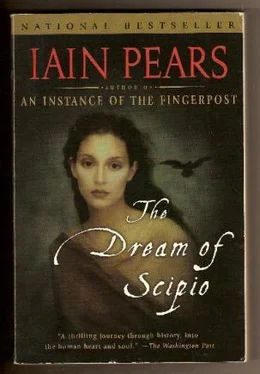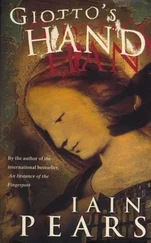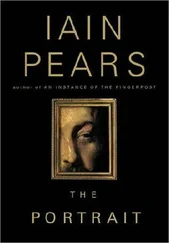Iain Pears - The Dream of Scipio
Здесь есть возможность читать онлайн «Iain Pears - The Dream of Scipio» весь текст электронной книги совершенно бесплатно (целиком полную версию без сокращений). В некоторых случаях можно слушать аудио, скачать через торрент в формате fb2 и присутствует краткое содержание. Год выпуска: 2002, ISBN: 2002, Издательство: Riverhead Books, Жанр: Историческая проза, на английском языке. Описание произведения, (предисловие) а так же отзывы посетителей доступны на портале библиотеки ЛибКат.
- Название:The Dream of Scipio
- Автор:
- Издательство:Riverhead Books
- Жанр:
- Год:2002
- ISBN:978-1-573-22986-9
- Рейтинг книги:4 / 5. Голосов: 1
-
Избранное:Добавить в избранное
- Отзывы:
-
Ваша оценка:
- 80
- 1
- 2
- 3
- 4
- 5
The Dream of Scipio: краткое содержание, описание и аннотация
Предлагаем к чтению аннотацию, описание, краткое содержание или предисловие (зависит от того, что написал сам автор книги «The Dream of Scipio»). Если вы не нашли необходимую информацию о книге — напишите в комментариях, мы постараемся отыскать её.
The Dream of Scipio — читать онлайн бесплатно полную книгу (весь текст) целиком
Ниже представлен текст книги, разбитый по страницам. Система сохранения места последней прочитанной страницы, позволяет с удобством читать онлайн бесплатно книгу «The Dream of Scipio», без необходимости каждый раз заново искать на чём Вы остановились. Поставьте закладку, и сможете в любой момент перейти на страницу, на которой закончили чтение.
Интервал:
Закладка:
It was of the Last Supper and, though the face of the Jesus conformed absolutely to what it must be, he had given the figure a similar gesture, that toss of the head, the movement of the shoulders, the slight upward glance and flash of the eye. Half in jest, Pietro held his finger to his lips.
“Our little secret,” he said. “But observe it well. Something of God is all around us, perhaps. All we need is eyes to see and a hand to capture.”
Lorenzetti dared no more, however; or perhaps that was the wrong word, for in his craft he was as absolute in his determination as any pope or emperor. He saw no need to. Still his figures for the most part needed to have something of the divine about them, needed to be recognizable as well. He would give them a gesture, a movement, an air that he had seen in the street, but could not go further. His art and his pride would not allow it. Knowingly or not, he turned from that last step, fearing it might lead to blasphemy, that he might be drawn into the conceit of making God, rather than humbly representing Him. Give the Blessed Virgin the face of an anxious mother? Have Saint Peter resemble a fisherman? Make Our Lord look like a carpenter? Thus formulated, Pisano had his answer, and the secret he took with him when he left for Avignon. He would take that extra step, or try to.
His first essay came when he was given the opportunity to do a whole painting himself in the entrance to the Cathedral of Our Lady in Avignon. Close by the doorway, but in a dark corner, a space of wall that needed filling but that no one would ever see unless they peered hard in the gloom, the contrast with the light flooding in through the door making it all but invisible. Too insignificant a spot for Matteo himself to bother with, so he farmed it out. And there Pisano painted a Virgin high up on the wall, being approached by a prince of the church, an appropriate scene for what was fast becoming the main cathedral of all Christendom. The Virgin was conventional, seated, with the child on her left arm; here he dared little. But with the figure before her he allowed himself to experiment. He painted this as a real man, standing rather than kneeling, giving an impression of power, almost of equality before the divine. And he gave it the face of Cardinal Ceccani, conveying through it the strange mixture of deference and command that that man had so perfected.
He was not pleased with it; he could do better, he knew. And Matteo was outraged and wanted it erased. It was he who sent word through the corridors of what Pisano had done, hoping to cause a scandal; the result had been that Ceccani himself, the next time he came to the cathedral, stopped and looked, peering up in the candlelight to see his own features flickering on the wall.
He stared, his eyes narrowed, he grunted. Then he turned to a priest standing nearby. A few weeks later, Pisano was summoned to the cardinal’s palace and given the commission to paint the chapel of Saint Sophia. So cryptic was his benefactor that Pisano could not be sure whether it was a reward or a punishment. Nonetheless, once the dismay and disappointment faded he realized the chapel would give him his chance. There were no conventionally understood notions of what any of the characters in the tales looked like, apart from the Magdalen; the chapel was isolated and unlikely to attract too much attention; he could experiment at will and see what resulted.
But whom could he choose? How could he decide? This practical detail had gnawed at him. He could not choose anyone; he had to find someone who, in some way, resembled what the saint must have looked like, which meant he had to know in his mind what that was. Hence his reference to prayer, for he was convinced that God would show him the way.
He had the face of the Magdalen easily, although he did not know where it came from; he sat down one morning and this handsome, tranquil face drew itself on the piece of slate he habitually used for idle jottings. It was not what he expected, certainly, but the pious painter was not one to query the will of Heaven; he had prayed and had then settled down to draw: this had been given him. A pretty face, young and charming even after the necessary artistic improvements had been made to make it conform, just a little, to what such a woman must have looked like. He knew well enough that it was probably the face of someone he had seen, someone glimpsed in the street, for he had an extraordinary memory for such things. But he had not the slightest idea who it was, or when he had seen her. His mind, or God, had joined the face with the subject; that was all he needed to know.
For the blind man, he decided he would allow himself a small jest—nothing impious—but painters were habitually permitted a little leeway in the matter of sinners. He used Olivier for this figure, a piece of whimsicality that made him smile throughout the business of transferring his sketches onto the chapel wall. For Olivier was, surely, such a person, forever seeking wisdom so he could see more clearly. But even he, this man he saw daily when he was in Avignon, he could not get right. He could draw his face, of course, that was easy. But he could not get the pair of them, the saint and the blind man, Olivier and this unknown other, to look anything other than two figures placed side by side, and he wanted more than that.
For Saint Sophia herself would not come to him, and as she was to occupy all the first panel and was to be a major figure in all the others as well, the lack reduced him to despair. He could, of course, have used a conventional image, but knew he must not; he had set out to do something new, and refused to retreat into the ordinary merely because a difficulty came to interrupt his progress.
So Pisano went to the chapel, then came back to Avignon having accomplished little, and there he moaned to Olivier and all the friends who were prepared to listen, prayed incessantly but to no avail. Even renewed visits produced only the barest outline of a face, until one day he was walking through the streets and saw the Blessed Saint Sophia, shopping at a market stall. He noticed nothing at first, and only became aware of her when Olivier turned pale and gasped in surprise.
Pisano noticed and followed his eyes, saw what he saw, and knew that his search was over. That was what the saint would look like, and that was how a blind man given back his sight would react, not with joy, not with a happy smile, but with something close to anguish, with a piercing cry and an expression of something approaching terror.
“Yes,” he cried. “That’s it. Perfect.”
Pisano began to dance up and down in his excitement, making so much noise that passersby turned to look, and the woman herself glanced around in fright and then hurried away.
“Hush, my friend,” Olivier said urgently. “Calm yourself.”
“Why should I be calm? You’re not. I’ve never seen anyone turn so sickly in my life. Who is she? Are you in love with her? You must be. Is this the woman you’ve been putting in all that doggerel you produce?”
“Be quiet,” Olivier snapped, so violently that Pisano for once ceased his otherwise endless babble. “I do not know who she is. But I am going to find out. Stay here. Don’t move, and above all, don’t talk.”
He pushed his friend away and told him to wait quietly at the corner of the street, then walked up to the seller of herbs she had bought from.
“Who was that woman you were talking to?” he asked.
The woman chuckled at his attempt at innocence. “The fat one?” she asked.
“No.”
“The old one with the warts? I have lots of customers.”
“No.”
“It couldn’t possibly be the beautiful one in the old cloak.”
He grinned.
“The one wearing the yellow star,” she added with a smirk as she saw Olivier’s face freeze.
Читать дальшеИнтервал:
Закладка:
Похожие книги на «The Dream of Scipio»
Представляем Вашему вниманию похожие книги на «The Dream of Scipio» списком для выбора. Мы отобрали схожую по названию и смыслу литературу в надежде предоставить читателям больше вариантов отыскать новые, интересные, ещё непрочитанные произведения.
Обсуждение, отзывы о книге «The Dream of Scipio» и просто собственные мнения читателей. Оставьте ваши комментарии, напишите, что Вы думаете о произведении, его смысле или главных героях. Укажите что конкретно понравилось, а что нет, и почему Вы так считаете.









![Theresa Cheung - The Dream Dictionary from A to Z [Revised edition] - The Ultimate A–Z to Interpret the Secrets of Your Dreams](/books/692092/theresa-cheung-the-dream-dictionary-from-a-to-z-r-thumb.webp)


